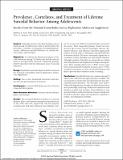| dc.contributor.author | Nock, Matthew K. | |
| dc.contributor.author | Green, Jennifer | |
| dc.contributor.author | Hwang, Irving | |
| dc.contributor.author | McLaughlin, Katie Anne | |
| dc.contributor.author | Nancy A. Sampson, BA | |
| dc.contributor.author | Zaslavsky, Alan M. | |
| dc.contributor.author | Kessler, Ronald | |
| dc.date.accessioned | 2017-09-06T15:50:46Z | |
| dc.date.issued | 2013 | |
| dc.identifier | Quick submit: 2017-05-24T09:52:04-0400 | |
| dc.identifier.citation | Nock, Matthew K., Jennifer Greif Green, Irving Hwang, Katie A. McLaughlin, Nancy A. Sampson, Alan M. Zaslavsky, and Ronald C. Kessler. 2013. “Prevalence, Correlates, and Treatment of Lifetime Suicidal Behavior Among Adolescents.” JAMA Psychiatry 70 (3) (March 1): 300. doi:10.1001/2013.jamapsychiatry.55. | en_US |
| dc.identifier.issn | 2168-622X | en_US |
| dc.identifier.uri | http://nrs.harvard.edu/urn-3:HUL.InstRepos:33839675 | |
| dc.description.abstract | Context Although suicide is the third leading cause of death among US adolescents, little is known about the prevalence, correlates, or treatment of its immediate precursors, adolescent suicidal behaviors (ie, suicide ideation, plans, and attempts).
Objectives To estimate the lifetime prevalence of suicidal behaviors among US adolescents and the associations of retrospectively reported, temporally primary DSM-IV disorders with the subsequent onset of suicidal behaviors.
Design Dual-frame national sample of adolescents from the National Comorbidity Survey Replication Adolescent Supplement.
Setting Face-to-face household interviews with adolescents and questionnaires for parents.
Participants A total of 6483 adolescents 13 to 18 years of age and their parents.
Main Outcome Measures Lifetime suicide ideation, plans, and attempts.
Results The estimated lifetime prevalences of suicide ideation, plans, and attempts among the respondents are 12.1%, 4.0%, and 4.1%, respectively. The vast majority of adolescents with these behaviors meet lifetime criteria for at least one DSM-IV mental disorder assessed in the survey. Most temporally primary (based on retrospective age-of-onset reports) fear/anger, distress, disruptive behavior, and substance disorders significantly predict elevated odds of subsequent suicidal behaviors in bivariate models. The most consistently significant associations of these disorders are with suicide ideation, although a number of disorders are also predictors of plans and both planned and unplanned attempts among ideators. Most suicidal adolescents (>80%) receive some form of mental health treatment. In most cases (>55%), treatment starts prior to onset of suicidal behaviors but fails to prevent these behaviors from occurring.
Conclusions Suicidal behaviors are common among US adolescents, with rates that approach those of adults. The vast majority of youth with suicidal behaviors have preexisting mental disorders. The disorders most powerfully predicting ideation, though, are different from those most powerfully predicting conditional transitions from ideation to plans and attempts. These differences suggest that distinct prediction and prevention strategies are needed for ideation, plans among ideators, planned attempts, and unplanned attempts. | en_US |
| dc.language.iso | en_US | en_US |
| dc.publisher | American Medical Association (AMA) | en_US |
| dc.relation.isversionof | 10.1001/2013.jamapsychiatry.55 | en_US |
| dash.license | LAA | |
| dc.title | Prevalence, Correlates, and Treatment of Lifetime Suicidal Behavior Among Adolescents: Results From the National Comorbidity Survey Replication Adolescent Supplement | en_US |
| dc.type | Journal Article | en_US |
| dc.date.updated | 2017-05-24T13:51:03Z | |
| dc.description.version | Version of Record | en_US |
| dc.relation.journal | JAMA Psychiatry | en_US |
| dash.depositing.author | Nock, Matthew K. | |
| dc.date.available | 2013 | |
| dc.date.available | 2017-09-06T15:50:46Z | |
| dc.identifier.doi | 10.1001/2013.jamapsychiatry.55 | * |
| workflow.legacycomments | cat.complete | en_US |
| dash.contributor.affiliated | McLaughlin, Katie | |
| dash.contributor.affiliated | Hwang, Irving | |
| dash.contributor.affiliated | Kessler, Ronald | |
| dash.contributor.affiliated | Zaslavsky, Alan | |
| dash.contributor.affiliated | Nock, Matthew | |


